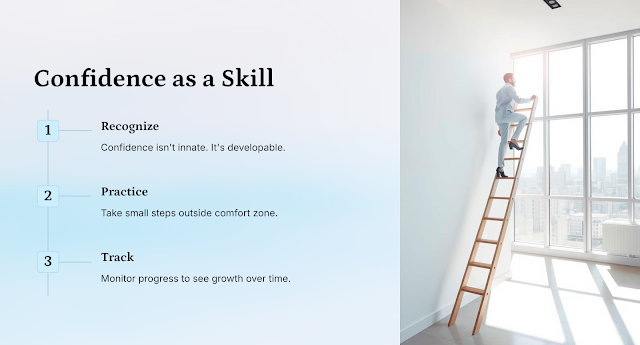Confidence Cheat Sheet: Looking to boost your confidence? Based on Katty Kay and Claire Shipman’s insights in The Confidence Code, here are some powerful, practical tips to help you build genuine confidence. In this summary, we break down essential takeaways and provide actionable steps to apply these insights in your daily life.
1. Understand that Confidence is a Skill
Confidence is not something you either have or don’t have; it’s a skill that can be built through effort and practice. Many people mistakenly believe confidence is only for the naturally bold, but that isn’t true! Like any other skill, it can be learned and improved.
How to Apply: Start small by regularly stepping out of your comfort zone. Each small achievement adds to your confidence foundation. Track your efforts and review your progress periodically to reinforce your growth.
2. Take Action Over Perfection
One of the main barriers to confidence is the belief that conditions need to be “perfect” before you can act. This mindset, which often affects women, can lead to overthinking and hesitation. Instead, focus on taking action, which is the quickest way to build confidence.
How to Apply: Embrace a “done is better than perfect” approach. Practice taking small risks and acting before you feel completely “ready.” Taking action, no matter how small, builds confidence faster than aiming for perfection.
3. Embrace Failure as Part of Growth
Fear of failure can hold people back from pursuing their goals, but failure is an essential part of learning and growing. In fact, the authors argue that setbacks teach you resilience and make you stronger.
How to Apply: Reflect on your past failures and consider what they taught you. Use this insight to frame future failures as learning opportunities rather than roadblocks.
4. Silence Your Inner Critic
Everyone has an inner critic, but letting it control your thoughts can destroy confidence. Negative self-talk often magnifies insecurities, which can become a significant hurdle to self-confidence.
How to Apply: Practice self-compassion by reframing negative thoughts into neutral or positive ones. Try mindfulness techniques to stay aware of unhelpful self-talk and replace it with constructive self-reflection or affirmations.
5. Use Body Language to Build Inner Confidence
Your body language doesn’t just reflect your confidence—it can influence it. Simple changes in posture and expression can have a powerful effect on how you feel about yourself.
How to Apply: Try power poses, such as standing with your feet apart and your hands on your hips, to feel more assertive. Practice these poses before important meetings or events to give yourself an instant confidence boost.
6. Focus on Competence, Not Just Confidence
Confidence that is based on competence is more sustainable and resilient. Building confidence through competence means focusing on developing skills and deepening your knowledge, which reinforces true self-assurance.
How to Apply: Dedicate time weekly to skill-building in areas that matter to you. As you grow more competent, you’ll naturally feel more confident. This creates a solid foundation of self-assurance rooted in real ability.
In summary, The Confidence Code reveals that confidence is a skill that can be cultivated through small actions, resilience in the face of failure, and by practicing habits that reinforce self-belief. Use this cheat sheet as a guide to build a lasting confidence that empowers you to achieve your goals and embrace growth.






